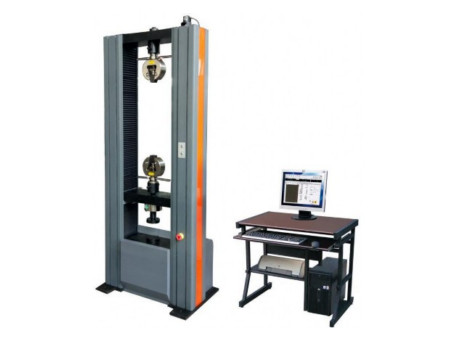- Qinsun Instruments Co., Ltd.
- Tell:+86-21-6780 0179
- Phone:+86-17740808215
- Address:No. 2578 Minhang District Gu Dai Road, Shanghai
- Contact:Mr. Li
- QQ:846490659
What to Consider When Selecting a Tensile Testing Machine?

Choosing the Right Tensile Testing Machine: A Comprehensive Guide
Selecting the appropriate tensile testing machine is a critical decision for laboratories, manufacturing facilities, and research institutions involved in material testing. The right machine ensures accurate and reliable results, impacting product quality and compliance with industry standards. In this guide, we will explore key factors to consider when selecting a tensile testing machine.
1. Types of Tensile Testing Machines:
Universal Testing Machine (UTM):
- Description: UTMs are versatile and widely used for various materials, including metals, plastics, rubber, textiles, and more.
- Advantages:
- Suitable for a wide range of materials and applications.
- Capable of performing tension, compression, and bending tests.
- Considerations:
- May be overkill for applications with specific and limited testing requirements.
Single-column Tensile Tester:
- Description: These machines are suitable for testing smaller and less rigid materials.
- Advantages:
- Compact design, making them suitable for limited spaces.
- Cost-effective for specific applications.
- Considerations:
- May have limitations on the size and type of specimens that can be tested.
Dual-column Tensile Tester:
- Description: Dual-column machines provide increased stability and are suitable for testing larger and more rigid materials.
- Advantages:
- Enhanced stability for larger specimens.
- Suitable for a broader range of materials.
- Considerations:
Requires more space compared to single-column machines.

2. Force Capacity:
Determining Force Requirements:
- Consider the range of forces your application requires.
- Choose a machine with a force capacity that exceeds your maximum testing force to allow for flexibility.
- Consider future testing needs and potential growth in testing requirements.
3. Speed and Testing Rate:
Test Speed:
- Different materials and standards may require specific test speeds.
- Consider the range of speeds the machine can achieve.
- For dynamic or cyclic testing, choose a machine with variable speed capabilities.
Adjustable Testing Rate:
- Certain applications require precise control over the rate of force application.
- Ensure the machine allows for adjustable testing rates to meet specific standards.
4. Grips and Fixtures:
Selecting Appropriate Grips:
- Different materials and specimen shapes may require specific grips.
- Consider the ease of changing grips to accommodate various specimen types.
Environmental Chambers:
- For testing under specific environmental conditions (temperature, humidity), choose a machine that supports environmental chambers.
- Ensure compatibility with chambers for accurate simulation of real-world conditions.
5. Accuracy and Precision:
Load Cell Accuracy:
- Select a machine with a load cell that provides the required level of accuracy for your testing needs.
- Higher accuracy is essential for applications with tight tolerances.
Extensometer Accuracy:
- For precise measurement of elongation, choose an extensometer with the required level of accuracy.
- Ensure compatibility with the machine's control system.
6. Software and Data Acquisition:
User-Friendly Software:
- Choose a machine with intuitive and user-friendly software for test setup, data acquisition, and analysis.
- Consider software that provides real-time data visualization.
Data Storage and Retrieval:
- Evaluate the capacity for data storage and the ease of retrieving historical test data.
- Consider software that allows for customization of test reports.
7. Compliance with Standards:
Industry Standards:
- Ensure the selected machine complies with relevant industry standards for your specific applications (ASTM, ISO, EN, etc.).
- Check if the machine has undergone calibration and meets regulatory requirements.
8. Maintenance and Support:
Ease of Maintenance:
- Choose a machine with a design that facilitates easy maintenance, including access to critical components.
- Consider machines with features that minimize wear and tear.
Supplier Support:
- Select a reputable supplier with a track record of providing excellent customer support.
- Check for the availability of spare parts and technical assistance.
9. Budget Considerations:
Total Cost of Ownership:
- Consider the total cost of ownership, including initial purchase cost, maintenance, and potential upgrades.
- Balance the budget with long-term performance and reliability.
10. Safety Features:
Operator Safety:
- Choose a machine with safety features to protect operators during testing.
- Consider features such as emergency stop buttons, interlocks, and safety shields.
Specimen Protection:
- Ensure the machine has features to prevent damage to specimens, especially during specimen failure.
- Consider machines with automatic shut-off to prevent overloading.
Conclusion:
Selecting the right tensile testing machine is a crucial decision that directly impacts the quality and reliability of material testing. By carefully considering factors such as machine type, force capacity, speed, grips, accuracy, software, compliance with standards, maintenance, budget, and safety features, you can make an informed decision that aligns with your specific testing requirements.
Whether you are involved in quality control, research and development, or manufacturing, choosing a tensile testing machine that meets your needs will contribute to accurate and meaningful test results, ensuring the integrity of materials and products in various industries.





